In this DIY tutorial we will show how to make a DIY concrete countertop as well as 5 concrete mistakes to avoid.
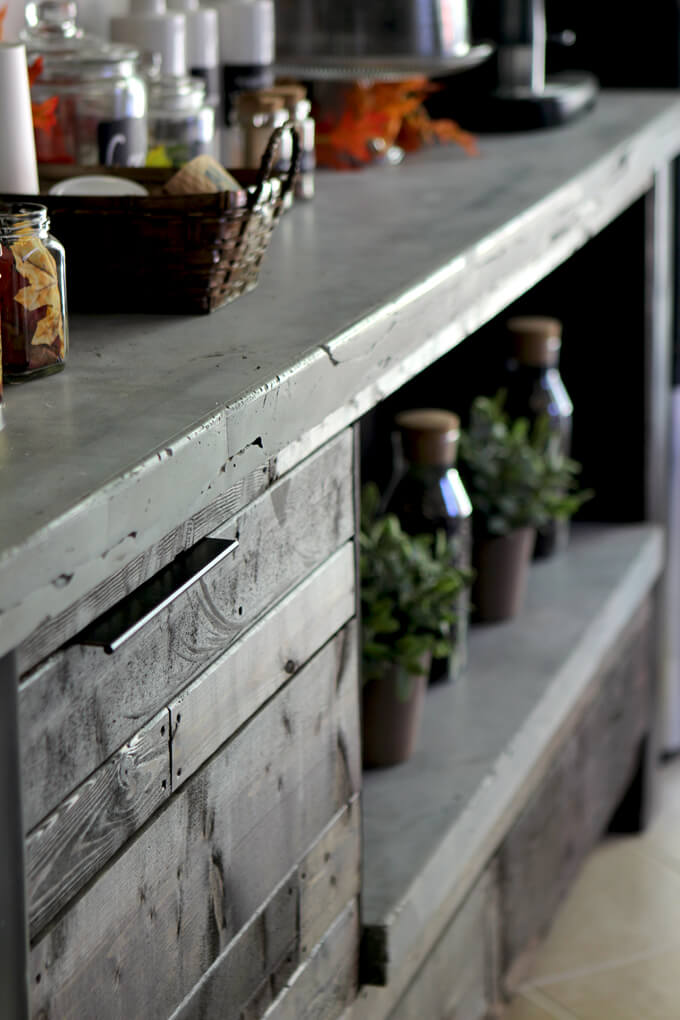
Hey everyone! It’s Brent here today sharing all the details about the DIY concrete countertop we built for our coffee bar.
It has been several months since we finished the concrete countertop on our coffee bar and we haven’t been anxious to post about it because it was a pretty frustrating experience.
However, we have been asked several questions about how we made the top of our coffee bar so now that the appropriate amount of time has passed that we can laugh about our mistakes, we are sharing the whole messy process.
This was our first time to use concrete on such a large scale so needless to say there were aspects of making the DIY concrete countertop that were frustrating.
Despite how crazy the process was, we are extremely pleased with the finished result. It turned out amazing. So we are here to tell you the never give up pep talk works.
Before we jump in and show you how we poured the concrete slab, we thought it would be important to share five DIY concrete countertop mistakes to avoid to help others bypass the battle that we went through.
5 DIY Concrete Countertop Mistakes to Avoid
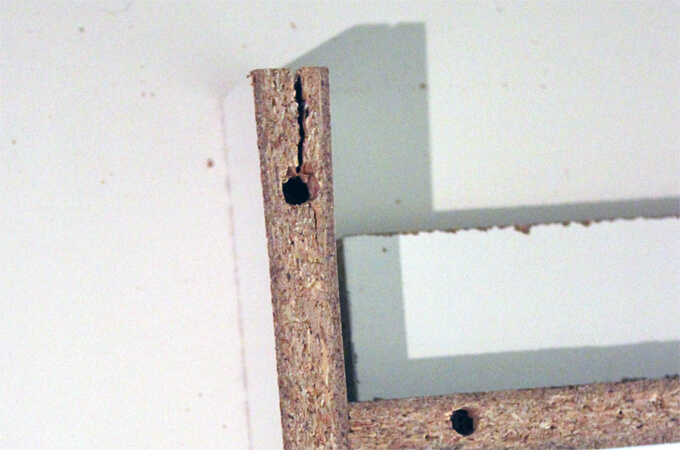
1. OVER TIGHTEN SCREWS IN THE FORM
The walls of the melamine form is attached to the base with screws. If the screws are over tightened the walls of the form will split and warp.
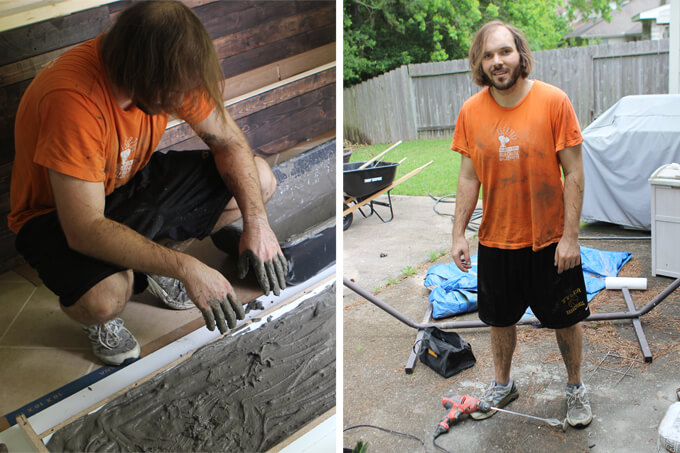
2. FLY SOLO
The plan was for Courtney to document the project but it didn’t take long before I was frantically asking her to put the camera down to help me. Since concrete only has a small window to work with it is important to have an extra pair of hands around.
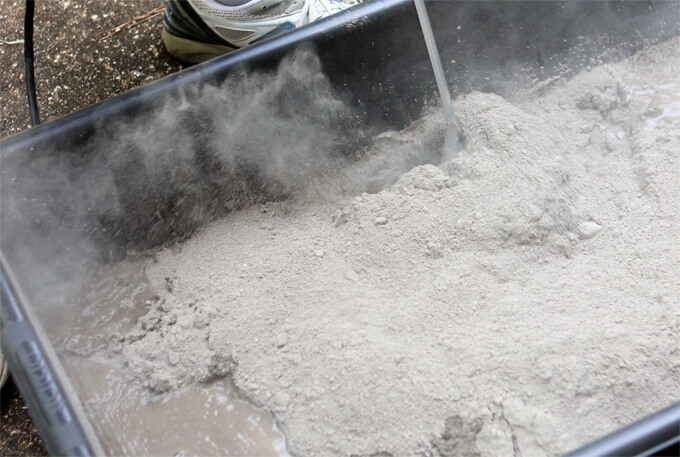
3. MIX BY HAND
We bought a large tub to mix the concrete in and thought we were prepared because we would be able to mix two bags at one time. We needed five bags for the largest slab.
While the tub did allow us to mix more concrete in a single batch, doing it by hand took way too long and the concrete started setting up in the tub. Plus, the more concrete we mixed in the tub the tougher it was to transport to our form.
A mixer allows you to mix and transport multiple bags of concrete without worrying about the concrete setting up. It is worth $45 dollars to rent a concrete mixer for a day.
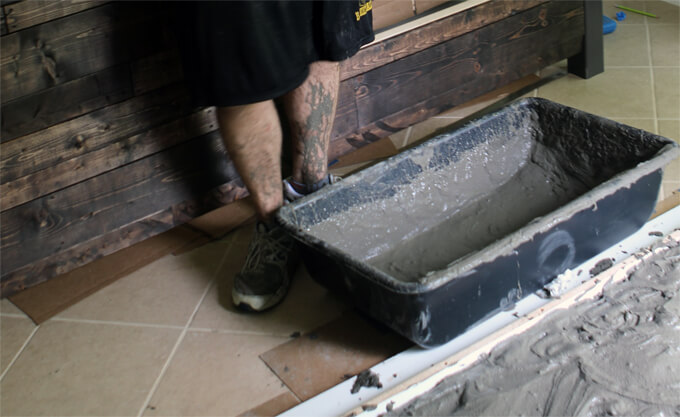
4. THINK YOU WON’T MAKE A MESS
We didn’t have enough space in our garage for this project and we figured since the piece of furniture would ultimately be situated in our breakfast nook, we might as well build it there.
We covered the tile floor with plastic and cardboard to protect it from any stray concrete and luckily no concrete escaped the plastic.
However, there was one moment where I slipped coming in from outside with 80 lbs. of mixed concrete in my arms.
It was in that moment while I was trying desperately not to spill any of the concrete onto our kitchen floor that I realized you can’t guarantee a project with no mess and it is best to take every precaution when planning a project.
It is also probably wise to make sure you have plenty of time to complete a project before you begin.
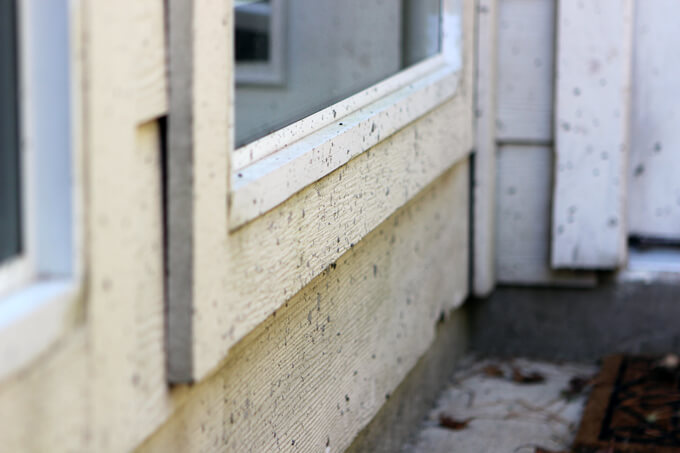
5. BELIEVE CONCRETE IS EASIER TO CLEAN AFTER DRY
Dry concrete flakes off slick surfaces easily but we learned not painted surfaces. We mixed the concrete on our back patio and in the disarray of the time crunch, splattered quite a bit of wet concrete on the house.
Worried about the concrete mix drying, we assumed the concrete splatter would flake off once dry.
Well, you know what happens when you assume. The concrete fused to the paint and the only way we found to remove it was to pressure wash it AND the paint completely off the siding.
Repainting the back of the house has now been moved up on our to-do list. Oops.

Get a FREE digital file of our hand painted Summer Bucket List print over at our print shop website: MoonRockPrints.com
How We Made the DIY Concrete Countertop for our Coffee Bar
SUPPLIES
- 4’x8′ Sheet of 3/4″ Melamine
- Table Saw
- Drill
- Black Silicone Caulk
- Painter’s Tape
- Welded Steel Wire
- Bolt Cutters
- Denatured Alcohol
- Bucket
- Precision Grout by Quikrete
- Large Concrete Mixing Tub
- Paddle Drill Attachment
- Trowel
- Metal Wire Mesh
- Orbital Sander
- Pliers
- Plastic Sheeting
FYI: This post contains a few affiliate links to products we used to make this project. Gray House Studio does receive commissions for sales from these links but at no extra cost to you. We appreciate you supporting this site. Read our privacy and disclosure policy. You can also easily shop our recommended products here.
STEPS
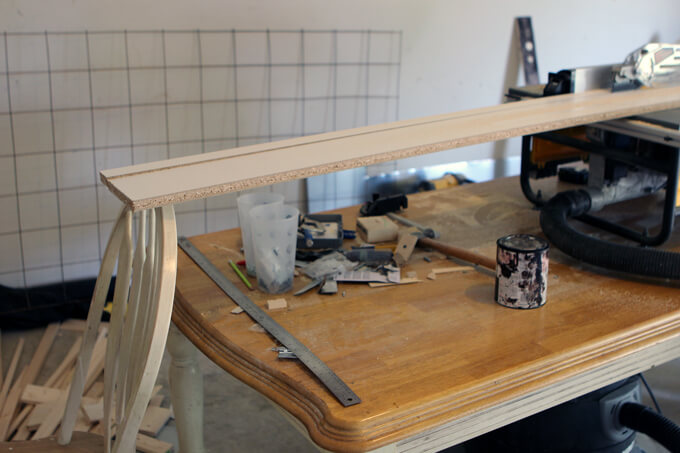
1. First we took a 4’x8′ sheet of 3/4″ melamine board and cut into strips.
The width of each melamine strip should be the same size as the DIY concrete counter top will be thick.
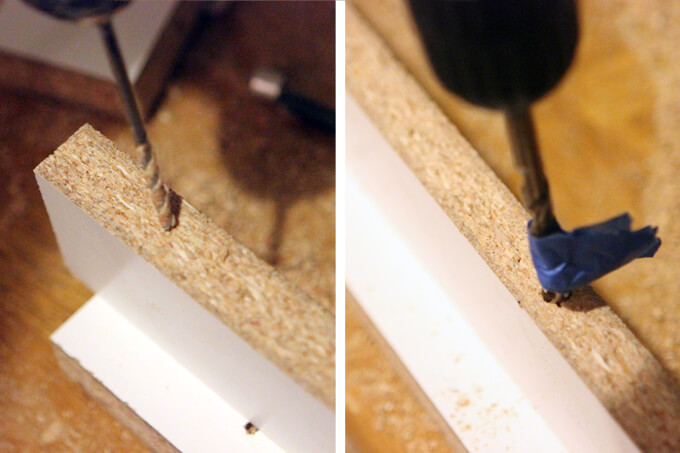
2. Once the strips were cut to the correct length to frame the outside of each slab, we used a drill and drill bit to pilot holes for the screws.
First we used a drill bit slightly larger than the threads of each screw and drilled all the way through each melamine strip.
After drilling through the entire width of the melamine strips, we used a drill bit slightly larger than the head of the screw to drill down about 1/4″ allowing the screw to be countersunk below the surface.
To avoid drilling too deep with the larger drill bit we wrapped painter’s tape around the bit to mark the correct depth.
After drilling all the pilot holes we attached the strips to the surface of a second sheet of melamine with screws.
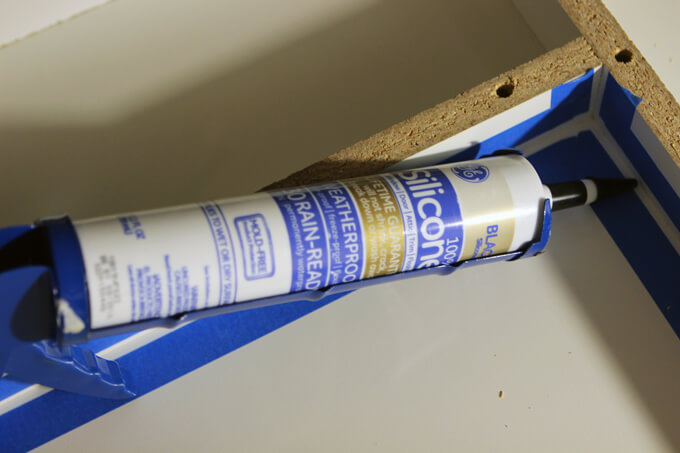
3. To create a water tight form for the concrete, we used black silicone caulk to fill the seams. We used painter’s tape to mask the surface of the melamine and create a clean caulk line.
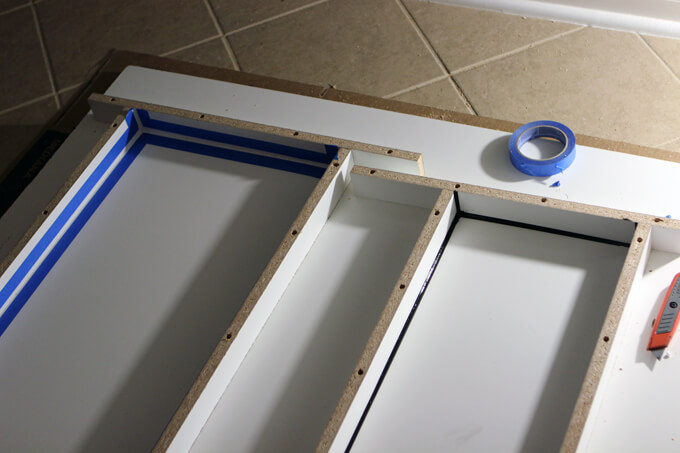
4. After smoothing the caulk with our fingers, we removed that tape before the caulk dried to create a smooth finish.
The dark color of the caulk made it easy to see where any caulk is out of place.
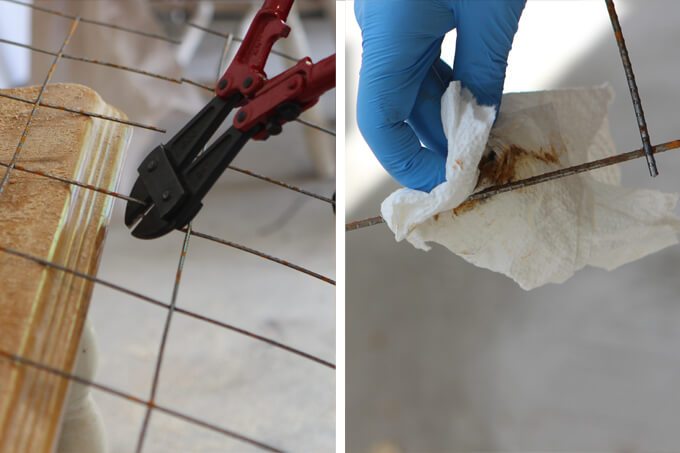
5. To create the strongest slab possible we used welded steel wire to reinforce the concrete.
After cutting the wire with a pair of bolt cutters we used denatured alcohol and a rag to wipe off any rust.
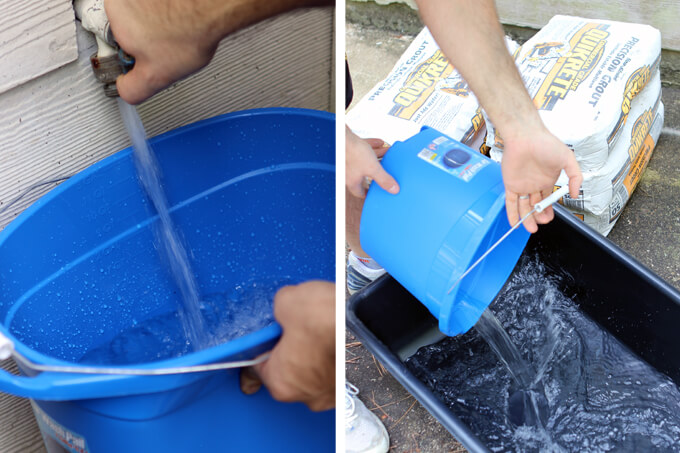
6. With the form complete it was finally time to mix the concrete.
We used precision grout by Quikrete to make our counter top.
We started by using the recommended water to concrete ratio but realized after the first batch that we needed to pour slightly more water from a bucket than the bag recommended to provide adequate dry time.
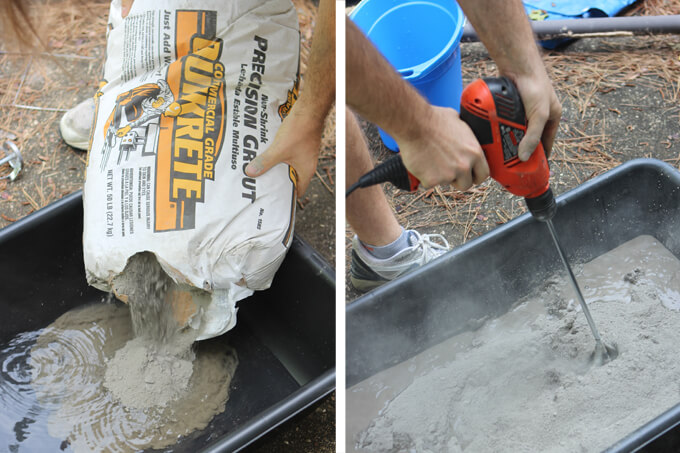
7. We poured half the mix into a large concrete mixing tub and all the water from the bucketbefore using a mixing paddle attached to a drill to blend the concrete together.
Once it blended into a consistent mixture, the rest of the dry mix was added.
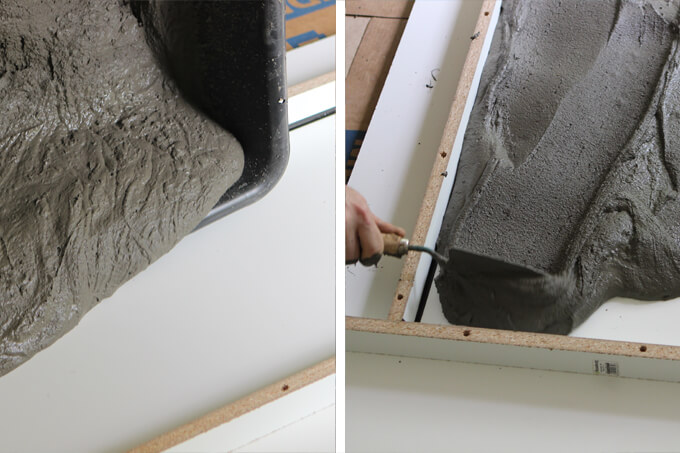
8. We mixed two bags of concrete at a time and it definitely takes more than one person to lug that much concrete around.
After pouring the concrete into the form we used a trowel and shovel to spread the concrete out.
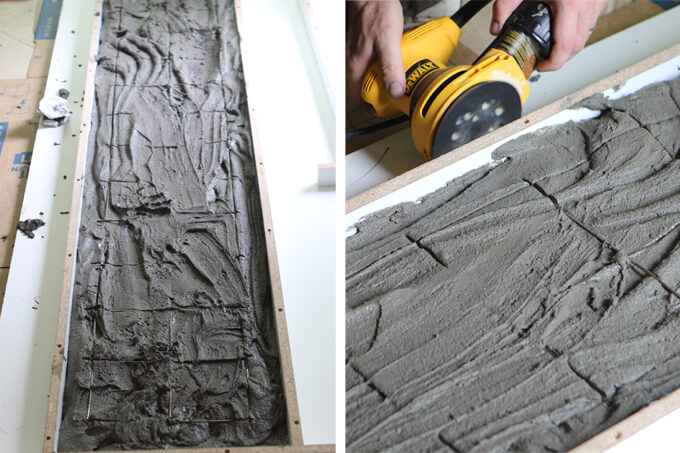
9. After the first batch was in the form and smoothed out we added the metal wire mesh. We used an orbital sander to vibrate the mixture to shake any air pockets to the surface to create a smooth finish.
We mixed the second batch of concrete and filled the rest of the form. With the entire form filled we vibrated it once more and covered the two slabs with plastic to allow the concrete to cure as slowly as possible.
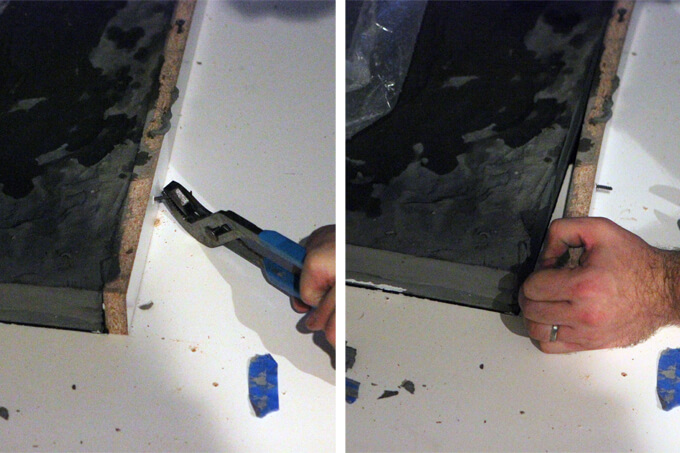
10. Once the counter top had time to cure we unscrewed the walls of the form from the base but found that it was difficult to remove the boards.
We were able to remove the boards by attaching screws to the side of each board and pulling on the screws with pliers.
After we had the concrete slab loose, we lifted it up and placed it on top of the coffee bar base we built.
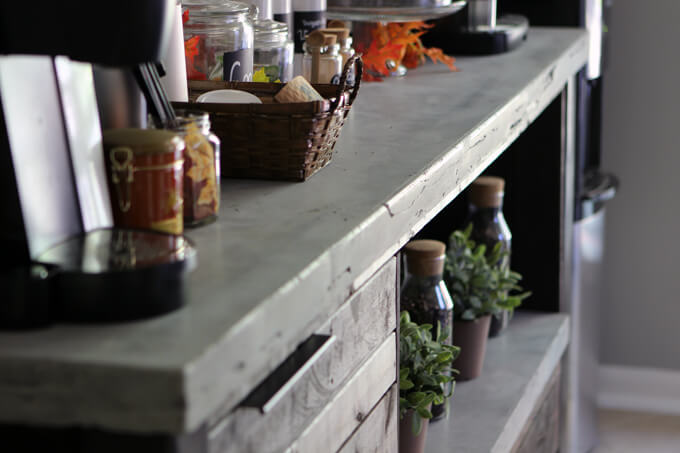
We could pretend that we are experts on everything DIY but that just wouldn’t be true.
We are still learning as we go and a lot of the times we just don’t know what problems could arise until we are knee deep in the middle of the project and run right into them.
But the best thing to do is to not give up, push through the challenges and learn from your mistakes for the next time. This was our experience making the DIY concrete countertop.
We hope this post will shed some light on our process of making a concrete countertop for our coffee bar.
Don’t forget to see out how we built the base of our coffee bar as well as check out how our finished coffee bar turned out.
I can’t wait to work on my first woodworking project with my new upgraded dust collector.
PIN FOR LATER
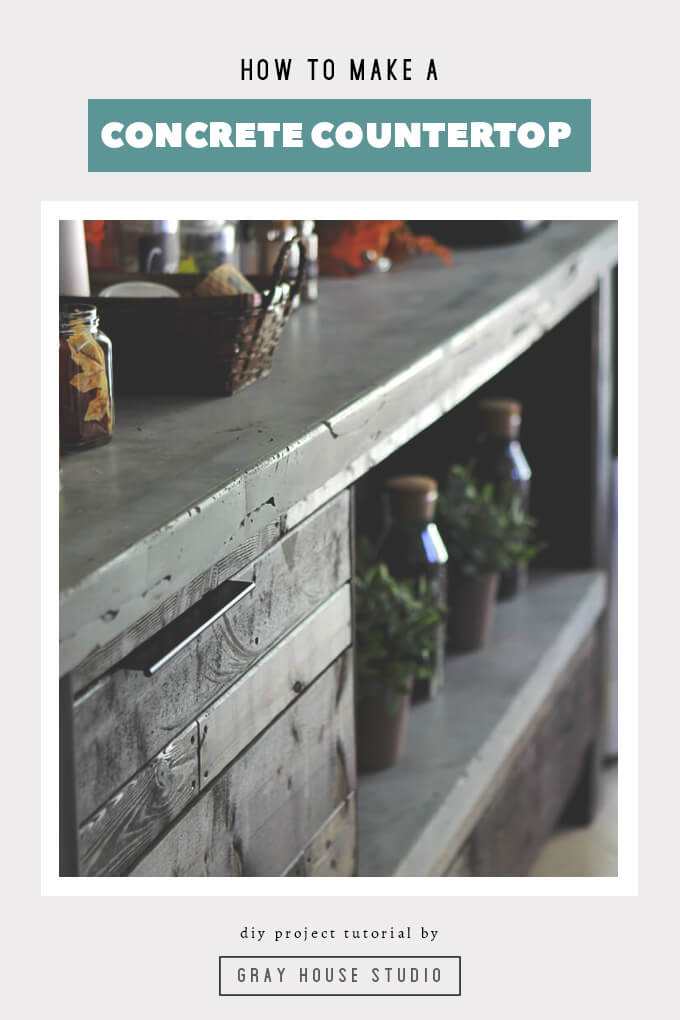

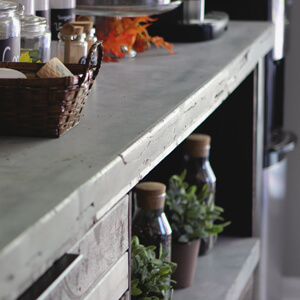

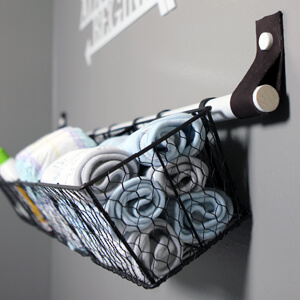
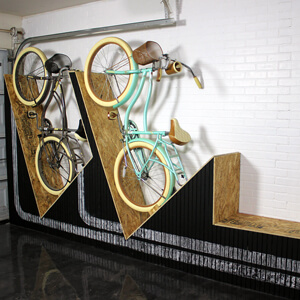

Hello, Thank you for pioneering this project. Because of your fails, success and plans, I finished my project. I love the the results. My wife who was skeptical at first now loves the bar and countertop! I used the cement mixer per your advice, saved headache, excessive mess and time. Very grateful for stumbling upon your blog. Much success on future projects, my house is counting on them!
Hi! That is great to hear and we are excited to know that some of our frustration helped you avoid problems. Would you mind sharing some pictures of your project? We would love to share on the site. You can send any photos to inspired[at]studiograyhouse.com or tag us on social media @grayhousestudio
Hello, curious as to your choice of using Precision Grout over the 5000 product?
Hi, The Quikrete 5000 concrete mix will work great but we chose the precision grout for our concrete countertop because it does not contain any gravel aggregate. We like the extra smooth finish of the product without aggregate. You don’t have to worry about any gravel settling on the bottom of the form and poking it’s head through the surface of your concrete countertop.
Love what y’all did, next time, grease the inside of your forms. Cris I, heavy dose of olive oil, vegetable oil, Castor oil, any kind of thick oil and your form will slide off easier. It’s what we do in big time construction when we make forms for concrete walls, we grease the bejesus out of it and it comes right off, no troubles.
That’s my only two cents, everything else y’all did was spot on!
Thanks for the incite! We will have to give it a try next time we pour a concrete countertop.
Looks like you used Grout instead of concrete. Explains how you got it to be so smooth since their is no aggregate in mortar. Will have to try that since yours turned out great.
We just finished ours and would like your advice on what to use to seal them.
Cool! Our opinion is that any concrete sealer will work the same. The main decision is if you prefer a matte finish or glossy finish. Our preference is the Matte finish.
Is there a specific type of wire mesh that you used? Gague? Spacing of the squares?
I’m not sure the exact gauge and spacing without measuring it but this the is Remesh we used http://www.homedepot.com/p/Nucoar-42-in-x-84-in-Remesh-Sheet-361682/202090219
I would like to try this but how do you get the concrete so smooth. Is there something that can be used to shine it?
Hi Leslie, The melamine sheets we used to build the form create a smooth finish when removed from the dried concrete.
Hey Brent,
Thanks so much for an amazing article, I am going to be doing something similar this weekend and these tips were exactly what I needed. That being said could you share the dimensions of the slab (5 bags worth) you created? I was looking at the amount concrete the bags you used yielded and its said .45 cu ft (per bag) which with nothing to compare that to seems small. At least if you could tell me the dimensions I could know if mine is less or more then your table. Also, did you secure it to the area you added the slab…I imagine not given its weight. But if so…what did you use?
The concrete countertop on the coffee bar is 84 inches by 16 inches by 2 inches. After pouring the slab we would suggest getting one extra bag. We could only mix two bags at once and after losing a bit of each bag to the bottom of the bucket it was a stretch to fill the mold with the exact calculated number of bags. Just to be safe the countertop can be attached with Heavy Duty Liquid Nails.
I just completed a similar project and used Ardex Feather Finish over MDF….it looks like a solid piece of concrete but it isn’t heavy. A small bag covered our 60″ by 22″ counter. It’s a great product and saved my back and hours of clean up.
How did the edge turn out?
Thank you for sharing your talent. Where did you get the legs? I’m having a problem downloading the plans for the coffee bar? Is it just me??!!! 🙂
Hi Ellen, I hope you got Courtney’s email with instructions to download the plans. We made the legs by screwing 2x4s together and wrapping them with thin gauge sheet metal. -Brent
Did I miss it maybe, can u tell the measurements of this project to get a ballpark of how far the concrete will go so I can half or third the project supplies?
Hi Barbara! Aw, thanks so much for the kind words. We are so happy you stopped by our blog. That is awesome to hear you want to make a slab for in front of your fireplace. We used rectangular welded mesh to reinforce our concrete slab since it was on the large side. We chose to use that because it is rigid and provided more structural integrity.
We have never used hypertufa so if you use it for your project, we would love to hear your results and how you liked working with it.
The measurements for our concrete counter top are: 7 feet by 16 inches by 2 inches. We used five 50 pound bags for our countertop. Hope this helps! We are so glad you enjoyed the post and feel free to let us know if you have any more questions. Good luck with your project! 🙂
-Courtney
Wow u two are the BEST!!! I would follow u anywhere 😀 Thank you for sharing so humbly about your mistakes and the pitfalls. I would like to try to make a slab for in front of my fireplace and am thinking to reinforce it with something, like hardware cloth since my floor uneven and I (98#) will be stepping on it to build/tend fire. I thought to do slightly hypertufa which adds in some featherweight fluff to lighten the piece. Any thoughts. Many Blessings and thanx. U ROCK!!!
Hi there,
How heavy would you guess the top slab is? I’d love to take a try at making this but wondering how I can move the slab a distance into the house. Thanks!
Hi Justin,
The large concrete slab on the top took two people to lift. It took all of five 50lbs bags to make so it weighed somewhere around 250lbs. Luckily Courtney is strong and could help me by lifting the heavy side.
-Brent